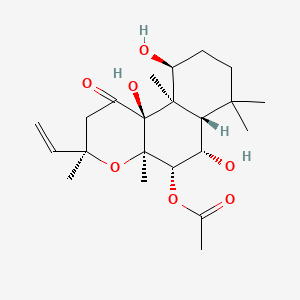| MeSH term | MeSH ID | Detail |
|---|---|---|
| Enterocolitis | D004760 | 3 associated lipids |
| Pain | D010146 | 64 associated lipids |
| Autoimmune Diseases | D001327 | 27 associated lipids |
| Lupus Erythematosus, Systemic | D008180 | 43 associated lipids |
| Lung Neoplasms | D008175 | 171 associated lipids |
| Adenoma, Islet Cell | D007516 | 7 associated lipids |
| Insulinoma | D007340 | 28 associated lipids |
| Pancreatic Neoplasms | D010190 | 77 associated lipids |
| Inflammation | D007249 | 119 associated lipids |
| Reperfusion Injury | D015427 | 65 associated lipids |
forskolin
Forskolin is a lipid of Prenol Lipids (PR) class. Forskolin is associated with abnormalities such as Cholestasis, Vocal cord dysfunction familial, Hypothyroidism, Renal tubular disorder and Disintegration (morphologic abnormality). The involved functions are known as Cell Proliferation, Anabolism, mRNA Expression, Agent and Signal. Forskolin often locates in Extracellular, Body tissue, Skin, Tissue membrane and Membrane. The associated genes with forskolin are P4HTM gene, SLC33A1 gene, NR1I2 gene, Genes, Reporter and CYP3A gene. The related lipids are Steroids, steroid sulfate, Fatty Acids, LYSO-PC and Lipopolysaccharides.
Cross Reference
Introduction
To understand associated biological information of forskolin, we collected biological information of abnormalities, associated pathways, cellular/molecular locations, biological functions, related genes/proteins, lipids and common seen animal/experimental models with organized paragraphs from literatures.
What diseases are associated with forskolin?
forskolin is suspected in Cyst, Kozlowski Celermajer Tink syndrome, Vocal cord dysfunction familial, Alzheimer's Disease, Cholestasis, Renal tubular disorder and other diseases in descending order of the highest number of associated sentences.
Related references are mostly published in these journals:
| Disease | Cross reference | Weighted score | Related literature |
|---|
Possible diseases from mapped MeSH terms on references
We collected disease MeSH terms mapped to the references associated with forskolin
PubChem Associated disorders and diseases
What pathways are associated with forskolin
Lipid pathways are not clear in current pathway databases. We organized associated pathways with forskolin through full-text articles, including metabolic pathways or pathways of biological mechanisms.
Related references are published most in these journals:
| Pathway name | Related literatures |
|---|
PubChem Biomolecular Interactions and Pathways
Link to PubChem Biomolecular Interactions and PathwaysWhat cellular locations are associated with forskolin?
Visualization in cellular structure
Associated locations are in red color. Not associated locations are in black.
Related references are published most in these journals:
| Location | Cross reference | Weighted score | Related literatures |
|---|
What functions are associated with forskolin?
Related references are published most in these journals:
| Function | Cross reference | Weighted score | Related literatures |
|---|
What lipids are associated with forskolin?
Related references are published most in these journals:
| Lipid concept | Cross reference | Weighted score | Related literatures |
|---|
What genes are associated with forskolin?
Related references are published most in these journals:
| Gene | Cross reference | Weighted score | Related literatures |
|---|
What common seen animal models are associated with forskolin?
There are no associated biomedical information in the current reference collection.
NCBI Entrez Crosslinks
All references with forskolin
Download all related citations| Authors | Title | Published | Journal | PubMed Link |
|---|---|---|---|---|
| Meents JE et al. | Sensitization of TRPA1 by Protein Kinase A. | 2017 | PLoS ONE | pmid:28076424 |
| Shi R et al. | Naringenin Regulates CFTR Activation and Expression in Airway Epithelial Cells. | 2017 | Cell. Physiol. Biochem. | pmid:29179179 |
| Cai P et al. | BMP4 inhibits PDGF-induced proliferation and collagen synthesis via PKA-mediated inhibition of calpain-2 in pulmonary artery smooth muscle cells. | 2017 | Am. J. Physiol. Lung Cell Mol. Physiol. | pmid:28235949 |
| Kruglov E et al. | Type 2 inositol trisphosphate receptor gene expression in hepatocytes is regulated by cyclic AMP. | 2017 | Biochem. Biophys. Res. Commun. | pmid:28327356 |
| Gerarduzzi C et al. | Prostaglandin E2-Dependent Phosphorylation of RAS Inhibition 1 (RIN1) at Ser 291 and 292 Inhibits Transforming Growth Factor-β-Induced RAS Activation Pathway in Human Synovial Fibroblasts: Role in Cell Migration. | 2017 | J. Cell. Physiol. | pmid:27137893 |
| Chen G et al. | AMP010014A09 in Sus Scrofa Encodes an Analog of G Protein-Coupled Receptor 109A, Which Mediates the Anti-Inflammatory Effects of Beta-Hydroxybutyric Acid. | 2017 | Cell. Physiol. Biochem. | pmid:28715817 |
| Lu N et al. | Butyric acid regulates progesterone and estradiol secretion via cAMP signaling pathway in porcine granulosa cells. | 2017 | J. Steroid Biochem. Mol. Biol. | pmid:28602959 |
| Takayama Y et al. | Brief exposure to small molecules allows induction of mouse embryonic fibroblasts into neural crest-like precursors. | 2017 | FEBS Lett. | pmid:28129669 |
| Malty RH et al. | Long-term exposure to PGE2 causes homologous desensitization of receptor-mediated activation of protein kinase A. | 2016 | J Neuroinflammation | pmid:27400965 |
| Li L et al. | Differential effects of lysophosphatidylcholine and ACh on muscarinic K(+),non-selective cation and Ca(2+) currents in guinea-pig atrial cells. | 2016 | Fukushima J Med Sci | pmid:26911304 |
